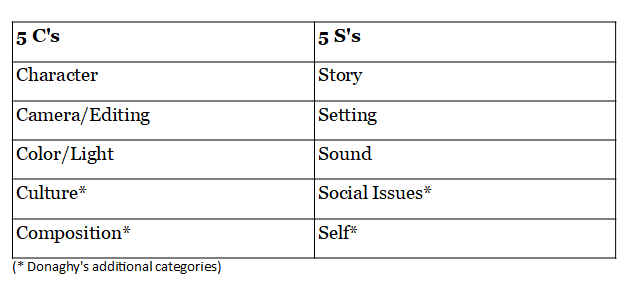Language learning is traditionally broken down into the four skills: Reading, Writing, Listening and Speaking. In a recent webinar, Kieran Donaghy drew our attention to a fifth skill: Viewing.
The concept of visual literacy has been an important topic in many undergraduate humanities programs for quite some time now.
As the world we live in is becoming more and more multimodal, it only makes sense that we also include images and films in language teaching. Donaghy quoted Sophia Mavridi:
As the offline and online worlds increasingly intersect, students need new sociocultural literacies to live, learn and communicate.
Multimodal refers to any form of communication that utilizes more than one mode to convey a message. So, for example, a book of poetry is not multimodal, but say, Allen Ginsberg reading HOWL, accompanied by conga and alto sax is.
A photo: not; but a photo with text: certainly.

So how can teachers facilitate visual literacy in the classroom?
Introducing the Five Core Concepts
As an introduction, Donaghy borrowed a slide from the Center of Media Literacy, which outlines five core concepts and related questions as follows.
| Five Core Concepts | Five Key Questions |
| 1. All media messages are ‘constructed.’ | 1. Who created this message? |
| 2. Media messages are constructed using a creative language with its own rules. | 2. What creative techniques are used to attract my attention? |
| 3. Different people experience the same media message differently. | 3. How might different people understand this message differently from me? |
| 4. Media messages have embedded values and points of view. | 4. What values, lifestyles and points of view are represented in, or omitted from, this message? |
| 5. Most media messages are organized to gain profit and/or power. | 5. Why is this message being sent? |
Extensive Viewing in the classroom
The actual process of integrating films into language lessons can be challenging and time-consuming. Luckily, I found a couple of viewing guides for films that I have really enjoyed on Donaghy’s Film- English website. His guides include a synopsis and discussion questions that are often specific to the film in question. They are part of the Extensive Viewing methodology and organized into three phases:
Pre-viewing, Viewing, and Post-viewing, comprising 7 stages in all. For an average class, the teacher would need to stretch the lesson over the course of several meetings.
The following lesson plan is for a drama about a divorce.
Pre-viewing: Stages 1-3
1) Priming
Discuss questions that focus on activating learner’s background knowledge and generating predictions.
- Can you think of the names of film dramas that you’ve seen?
- Do you know anyone who has ever been through a divorce themselves, or whose parents have divorced?
2) Focus on Context
Read the film synopsis (with a glossary of terms).
3) Glossary
Read the glossary of frequently used language along with synopsis of each section of the film before viewing. (Note: these glossaries can be quite long thus learners might need extra time to read them. Teachers may want to include translations for intermediate-level learners.)
Viewing: Stages 4-5
4) 1st Viewing
View film in its entirety (for pleasure).
5) 2nd Viewing
View film in sections after reviewing the glossary used in each section in order to better notice target vocabulary and how it is used.
Post-viewing: Stages 6-7
6) Multimodal Analysis of Film with the 5C’s and 5S’s Framework
The 5C and 5S frameworks organize the film into categorical areas of discussion. They expand on the 3 C’s and 3 S’s used by IntoFilm.
The following are a few of the questions organized into the film guide categories. They are intended to help learners develop their own personal response to the film.
STORY: Why do you think C fired his lawyer and hired a new one? Why did N choose to stay in LA?
CHARACTER: How does N and C’s relationship change over the course of the film? How would you describe H’s character? and so on…..
SETTING: How are New York and Los Angeles represented in the film? How important are the two cities to the story?
COLOR/LIGHT: How are the colors in New York and LA different? How is the light in New York and LA different?
SELF: Did you find the film easy to follow or confusing? What character did you empathize with the most? What do you think the message of the film is?
7) Multimodal Response
In the final stage, students are to produce a personal, multimodal response to the film. For example, they could write a review of the entire film or analyze a particular scene and incorporate still shots into their text. Or, they might record themselves summarizing the film.
SEE THINK WONDER — Visible thinking for still images
Donaghy summarized techniques like “visible thinking” to introduce and discuss still images in the classroom. He referred to a routine called “SEE THINK WONDER” in which the following questions can be asked about most images:
- What do you see?
- What do you think about that?
- What does it make you wonder?
Encourage the learners to use the same stems to scaffold their responses:
- I see…
- I think…
- I wonder…
The teachers should limit their role to summarizing the learners’ responses and encouraging group discussion.
Visual Thinking Strategies (VTS)
Visual Thinking Strategies (VTS) is another approach to introducing still images. It uses the following sequence of inquiries to challenge learners to find meaning in imagery and express their opinions:
What’s going on in this painting/photo?
After learners offer their opinions, the teacher then asks:
What do you see that makes you say that?
And then later to the group as a whole: What else can we find?
Final thoughts on the workshop
I enjoyed the workshop, but we certainly covered a lot of ground. If I remember correctly, there were more than 150 Power Point Slides over the course of a 150-minute-presentation.
Personally, I would have appreciated less time spent on the first part of the talk, which dealt with the importance of multimodal texts in curricular frameworks. That might have allowed more time to explore the second part of the talk, which dealt more hands-on with the use of multimodal texts in the ELT classroom.
***







